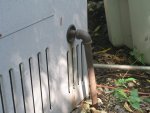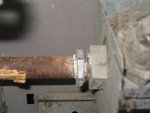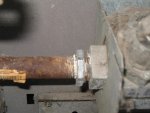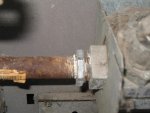- Jul 4, 2012
- 749
- Pool Size
- 21000
- Surface
- Vinyl
- Chlorine
- Salt Water Generator
- SWG Type
- CircuPool RJ-60 Plus
So, just as I was starting to consider heating options for next season (and cringing at the up front cost!), I come across a Hayward H-200 heater for $25! It is about 12 years old, neighbor says he has not turned it on in 3 years since they do not use the pool much anymore (kids grown) but it worked fine last time he did fire it up. I'm sure it needs some work, and I guess it could be dead, but first things first. I need to disconnect it myself.
It is no longer plumbed to the pool, just the gas line. Here is a picture. I checked the manual online but want to make sure I have things right. I assume the pipe to the left of elbow just screws right into the side of the unit, so I just unscrew that remove the elbow and cap what is poking up? He did say that the supply line has been turned off at the source, but I think capping it still makes good sense.
What tool would I use to unscrew the pipe going into the unit? A vice grip? I forgot to peak inside to see if it is actually fitted or just a cylinder. Or do I need to remove the panel to properly access?
Anything else I need to consider?
It is no longer plumbed to the pool, just the gas line. Here is a picture. I checked the manual online but want to make sure I have things right. I assume the pipe to the left of elbow just screws right into the side of the unit, so I just unscrew that remove the elbow and cap what is poking up? He did say that the supply line has been turned off at the source, but I think capping it still makes good sense.
What tool would I use to unscrew the pipe going into the unit? A vice grip? I forgot to peak inside to see if it is actually fitted or just a cylinder. Or do I need to remove the panel to properly access?
Anything else I need to consider?







